Q: What pesticides or other bug-killing methods work?
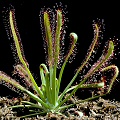
Drosera capensis
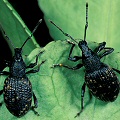
Weevils
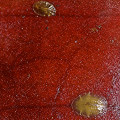
Scale
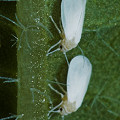
Whiteflies
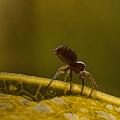
Darlingtonia spider
A: If your plants have pests, be creative about how you remove them.
Remove the pests manually (pluck them off) if you can.
In small plant collections this kind of
manual control is good for many kinds of
bug infestations, and does not involve the heady risks associated with pesticides.
Lady-bugs are of limited use as a biocontrol because they are rapidly
consumed by the plants! I once put a bag of a few thousand lady-bugs in my
greenhouse to control aphids. The pitcher plants loved them! The aphids were
unharmed.
Since carnivorous plants like water, people sometimes kill pests by submerging
plants completely in water for a few to several days. While I have used this
method successfully, I have also
managed to kill Cephalotus, Sarracenia, Utricularia,
and Dionaea this way. So while this method might be effective,
there is a technique that must be learned--tricks of the trade. For example, I think that the
water container be very large. If it is too small, something funky
happens and the water becomes nasty and smelly, then the plant dies.
Maybe it becomes anaerobic? I don't know. But in general I have abandoned this method.
If you insist on trying a chemical approach, good luck! Carnivorous plants are very
sensitive to chemicals. I almost never use pesticides on my plants.
Below I report on a number of compounds that have been used with varying degrees of effectiveness.
Before I launch into a discussion of chemicals, I need to make a few disclaimers.
- What works for one person may not work for everyone.
- I am not legally licensed to make pesticide recommendations. Check with your nearby agricultural extension agent or knowledgeable sales representative.
- I do not use pesticides too often, so there are lots of pesticides I don't know about. I only know about the ones that carnivorous plant growers use.
- If I recommend a pesticide, but you discover it has been discontinued in your area, don't try to locate, buy, and use the stuff illegally. When pesticides are discontinued, it is invariably for sound environmental reasons.
- For heaven's sake, whenever using pesticides, wear a mask, use gloves, and apply pesticides only outside where you have plenty of air circulation. (Of course, having good air circulation does not mean that the fumes from the pesticides disappear, it just means that they are blown away by the wind to kill other things in your environment.)
- Pesticides are formulated with the assumption that they will be used outside, or at least on plants that have plenty of exposure to air currents, and so on. Applying pesticides to terrarium plants may have surprising (possibly undesirable) effects, or long-term residual impacts.
- Use pesticides at full-label strength, as recommended by the manufacturer. Do not use pesticides at some strange diluted rate that you came up with (perhaps because carnivorous plants often do not like pesticides), because you will encourage the development of pesticide-resistant bugs.
- Some of the pesticides below are neonicotinoid (i.e, neonics). These are suspected as being related to the global death of bee colonies on the planet. If I use them--and sometimes I do--I make sure that pollinating bees cannot get to my treated plants for at least a year after treatment. Be responsible for your actions.
Here is something else to worry about: surfactants and inert ingredients.
If you look at a pesticide bottle, you will see that the active ingredient itself is
actually a tiny percentage of the mix you are buying. The rest of the
solution consists of "surfactants" and "inert ingredients." Surfactants are
compounds that help the pesticide stick to the bugs or plant.
Some surfactants are harmful to carnivorous plants. The inert
ingredients are mysterious, and by law are not required to be identified.
Who knows what your dark and mysterious pesticide
company put in that bottle. It could be quite toxic to your delicate carnivorous
plant. Are you willing to experiment?
What follows is a kind of laundry list of pesticide formulations and active ingredients. If you are going to do something odd, like put
a flea collar in your terrarium so the active ingredient evaporates into your terrarium atmosphere, investigate the active
ingredient below. Just because it is safe for your cat doesn't mean it is safe for your carnivorous plant!
Bacillus thuringiensis toxin (aka "Bt"):
Named after the bacterium that
produces the toxin, Bt is toxic to caterpillars. Beware that the
surfactants and other "inactive
ingredients" included in a bottle of Bt
could be dangerous to your plants. Did you know a tiny
bit of "Bt" sprinkled into water filled trays kill mosquito
larvae? Bt is harmless to
Utricularia and Aldrovanda (in my experience).
Cyfluthrin: A good mildly-systemic poison. This is usually an active ingredient
that comes in mixes of Imidacloprid. So I cannot say which is being effective--this or the Imidacloprid. One of these
two pesticides can cause damage to Dionaea and Utricularia,
too. But it's effective, in my book. See the entry on Imidacloprid.
Diazinon: Very effective against many pests, it is safe on
Sarracenia and some at least some Utricularia (in my experience).
I have not had problems with this chemical, and the surfactant and inert
ingredients seem OK to carnivorous plants.
Imidacloprid: A good mild systemic poison. I have had excellent luck with this,
although I get mild damage to Dionaea and I think it kills aquatic
Utricularia. See the entry on Cyfluthrin.
Isopropyl alcohol: A good contact poison. Use this on cotton swabs when
dabbing at aphids and mealy bugs. It kills them but good! A few drops, squeezed into
Sarracenia leaf axils, kills mealy bugs hiding there, too, and does
not seem to
harm the Sarracenia. (Note I have heard from others
who do not quite have my magical
"touch"---they killed their plants
with isopropyl alcohol!)
Isotox: I have never used this systemic insecticide, but reliable growers have told me they use
it for pests such as aphids on
Dionaea, Drosera and Utricularia, and those
plants tolerate the insecticide well. The active ingredient is acephate.
Kelthane: This showed no toxicity to a wide number of carnivorous plants
I tried this on (Sarracenia, Genlisea, Drosera,
Utricularia, Pinguicula
Dionaea). However, it did not kill all the aphids I was trying to treat,
either.
Malathion: This compound
has the advantage of being available in WP (wettable powder) form. This is good because it
seems that while Malathion itself is not too bad for carnivorous plants, the
solvents usually used to transform it to liquid form are harmful to carnivorous
plants. But oh boy, the WP form smells bad!
Marathon: This expensive
compound seems to be safe to Utricularia, and is a
good way to kill root mealy bugs that may infest them.
Orthene: Another formulation of acephate. See the entry on Isotox for more information.
Pyrethrum: A compound extracted from chrysanthemums, gardeners often
consider this more environmentally friendly than other pesticides. Some growers like using it on their
carnivorous plants, but I have seen it damage
pitchers and flowers of Sarracenia. Rumor has it that the damage is
cause by a common adjuvant added to Pyrethrum.
Soaps: Another relatively "green"
pesticide, unfortunately, this
seems to be deadly to carnivorous plants (although
some growers seem to use them safely).
Page citations: Rice, B.A. 2006a; personal observation.